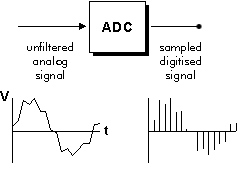In electronics, an analog-to-digital converter (ADC, A/D, or A-to-D) is a system that converts an analog signal, such as a sound picked up by a microphone, into a digital signal.
What is ADC?
ADC stands for Analog-To-Digital Converter, is any device for changing analog signals into digital transmission – for example, recording someone singing onto a CD. The pressure waves in the air produced by the vibration of the person’s vocal chords are analog in form and continually vary in strength within a certain range of values.

The recording equipment samples this continually varying information at discrete time intervals and converts it to digital form.
Analog-to-digital converters (ADCs) are used in industry to convert environmental variables (temperature, pressure, density, speed, and so on) that vary continuously over time to digital information, which can then be analyzed using computer programs. ADCs are used in analog modems to convert digital signals into audio and vice versa. To buy this type of device from Amazon just click here.
Nonlinearity
All ADCs suffer from nonlinearity errors caused by their physical imperfections, causing their output to deviate from a linear function (or some other function, in the case of a deliberately nonlinear ADC) of their input. These errors can sometimes be mitigated by calibration, or prevented by testing. Important parameters for linearity are integral nonlinearity and differential nonlinearity.
These nonlinearities introduce distortion that can reduce the signal-to-noise ratio performance of the ADC and thus reduce its effective resolution.
Accuracy
An ADC has several sources of errors. Quantization error and (assuming the ADC is intended to be linear) non-linearity are intrinsic to any analog-to-digital conversion. These errors are measured in a unit called the least significant bit (LSB). In the above example of an eight-bit ADC, an error of one LSB is 1/256 of the full signal range, or about 0.4%.
Dither
In ADCs, performance can usually be improved using dither. This is a very small amount of random noise (e.g. white noise), which is added to the input before conversion. Its effect is to randomize the state of the LSB based on the signal. Rather than the signal simply getting cut off altogether at low levels, it extends the effective range of signals that the ADC can convert, at the expense of a slight increase in noise.
Note that dither can only increase the resolution of a sampler. It cannot improve the linearity, and thus accuracy does not necessarily improve.
1byone ATSC Digital Converter Box – Analog TV Converter with Record and Pause Live TV
Let Your Analog TV Receive Local HDTV Channels!1byone Digital TV Converter Box converts over-the-air ATSC digital broadcasts for playback on your analog TV. Working together with your TV antenna, Digital Converter Box lets you enjoy all your local broadcasts for FREE from ABC, NBC, CBS, FOX and many others with expanded programming for kids, news, sports, sitcoms and more.
Check out the latest price (on Amazon)